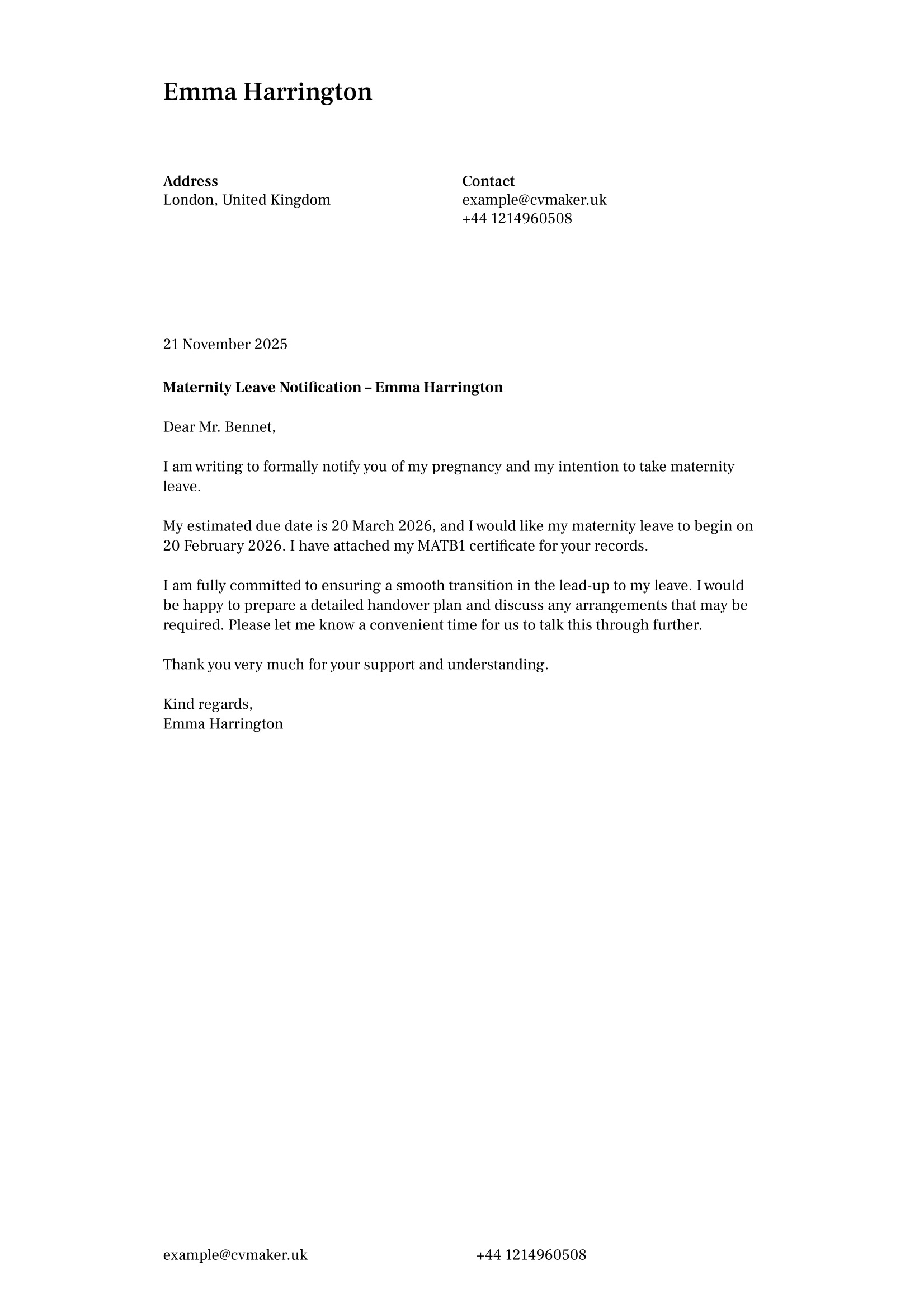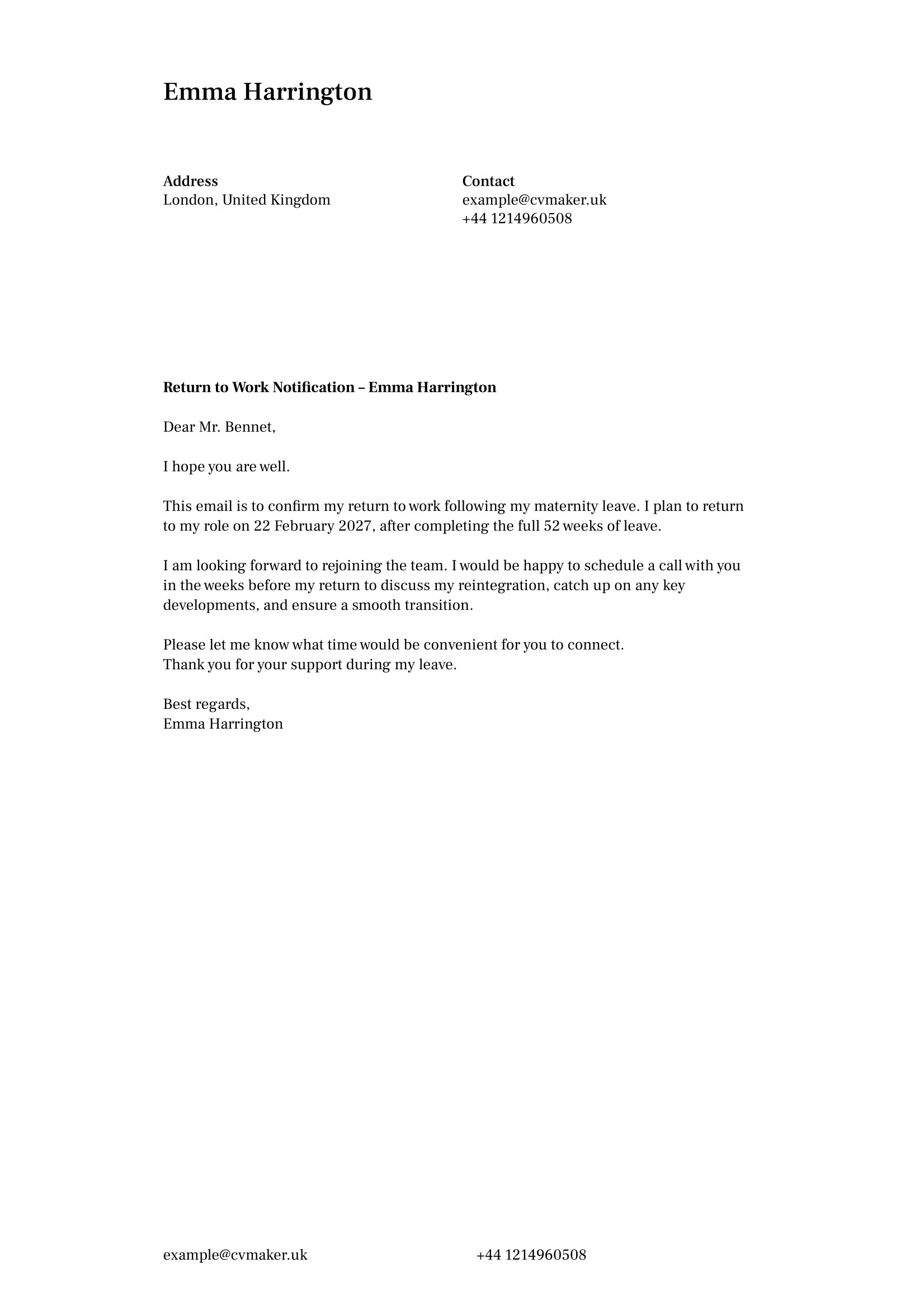If you're planning to go on maternity leave, are already on it, or simply want to know the details, the first step is understanding your rights, and how they fit into your wider employee benefits. Whether you work for the NHS, the civil service, a major company like Deloitte, or you’re self-employed, having clear, practical information about UK maternity leave will empower you to plan with confidence. With the right guidance, you can focus less on admin and more on preparing for this exciting chapter!
In this article, we cover:
How maternity leave pay is calculated
How to plan your leave
How to manage a CV gap after maternity leave
Tips for a smooth return to work.

Improve your CV after a career break!
What is Statutory Maternity Leave?
Statutory Maternity Leave is the time you are legally entitled to take off work when you have a baby.
This leave is a legal right that ensures your job is protected.
You are eligible if you are an employee and give your employer the correct notice.
It is available regardless of how long you have worked for your employer, the number of hours you work, or your compensation.
During your maternity leave, your employment rights are protected
This means you are still entitled to things like pay rises, holiday, and pension contributions. You are also protected from unfair dismissal or discrimination related to your pregnancy or leave.
How long is maternity leave in the UK?
Employees can take up to 52 weeks of maternity leave. This is divided into two parts:
Ordinary Maternity Leave: The first 26 weeks.
Additional Maternity Leave: The last 26 weeks.
You do not have to take all 52 weeks, but you must take at least two weeks of leave after your baby is born.
How is maternity pay calculated?
Understanding how maternity pay works is crucial for financial planning. There are two main types of maternity pay in the UK: Statutory Maternity Pay (SMP) and Maternity Allowance.
Statutory Maternity Pay (SMP)
To qualify for Statutory Maternity Pay, you must:
Be employed by the same employer continuously for at least 26 weeks up to and including the qualifying week (which is the 15th week before your baby is due)
Earn on average at least £125 per week (gross) during the relevant period
Give your employer the correct notice and proof of pregnancy.

How much is SMP and how is it paid?
SMP is paid for up to 39 weeks:
For the first 6 weeks: You get 90% of your average weekly earnings (before tax).
For the next 33 weeks: You get £187.18 per week (for 2025/2026) or 90% of your average weekly earnings, whichever is lower.
SMP is paid in the same way as your normal wages, and is subject to tax and National Insurance deductions.
Maternity Allowance
If you don't qualify for SMP, you may be able to get Maternity Allowance. This is usually for people who are employed but don't meet the SMP criteria, are self-employed, or have recently stopped working. You can claim it as early as 26 weeks into your pregnancy.
Maternity leave per sector
NHS maternity leave: Many NHS Trusts offer enhanced maternity pay above the statutory minimum. For example, some schemes provide about 8 weeks at full pay, followed by 18 weeks at half pay, then the statutory maternity pay for the remainder (often around 13 weeks), and then possibly unpaid leave. Eligibility can depend on length of service, contract type and whether you agree to return to NHS employment.
Civil service and large private companies: Many civil service employees and large private employers have generous maternity-leave schemes, offering longer periods at full pay, enhanced pay above the statutory minimum, and support such as return-to-work programmes and flexible working. These enhancements are detailed in the company/department’s HR handbook and may vary by role and length of service.
Self-employed workers: If you don’t qualify for statutory maternity pay through an employer, you may be eligible for the government’s Maternity Allowance, which provides up to 39 weeks’ payment at a set rate (or a percentage of your earnings) subject to eligibility criteria. As a self-employed person, you don’t have the same employer-based maternity leave scheme, so it’s best to check your eligibility early and plan accordingly.
How to plan your maternity leave
A smooth transition into maternity leave requires some simple planning. This involves communicating clearly with your employer and understanding your options.
When to start your maternity leave
You can choose to begin your maternity leave any time from 11 weeks before your baby’s expected week of childbirth up to the day your baby is born.
Your maternity leave will automatically begin if you are off work due to a pregnancy-related illness (or suspended for health & safety reasons) within the final 4 weeks before your baby is due.
How to give notice to your employer
You must tell your employer you plan to take maternity leave no later than 15 weeks before the week your baby is due.
Your notice must include confirmation of your pregnancy, your expected week of childbirth, and the date you intend to start your maternity leave.
The MATB1 form (issued by a doctor or registered midwife) verifies your pregnancy and expected week of childbirth. It must not be issued more than 20 weeks before your expected week, and you should provide it to your employer (or keep it ready) as proof when claiming statutory maternity pay or allowance.
It’s best to put this in writing so you have a formal record.
Maternity leave notification example

Download this free maternity leave message template in PDF.
What are "Keeping in Touch" (KIT) days?
You can work up to 10 “Keeping in Touch” (KIT) days during your maternity leave without bringing your leave or your statutory maternity pay to an end.
Even a small amount of work (e.g., a few hours) counts as one full KIT day.
They can be used for activities such as attending training, working on a project, or joining team meetings while on maternity leave.
They are optional and must be agreed upon by both you and your employer.
Pro tip
Pay for a KIT day must be agreed in advance. You should receive at least the National Minimum Wage, and the amount might be the normal daily rate or a different agreed amount. If you exceed the 10 KIT day limit, your maternity leave and/or pay may automatically end.
Returning to work after maternity leave
Thinking about returning to work after a career break can feel overwhelming, but you have rights that support this transition.
If you take Ordinary Maternity Leave (up to 26 weeks), you have the right to return to the exact same job on the same terms.
If you take Additional Maternity Leave (26–52 weeks), you still have the right to return to the same job, unless it is not reasonably practicable. If that happens, your employer must offer a suitable alternative role with the same or better pay, benefits, seniority and conditions.
Many parents find that they need more flexibility upon returning to work. You have the legal right to request flexible working arrangements, such as part-time hours or working from home.
NHS and Civil Service: These sectors often provide additional support, such as phased returns, temporarily reduced hours, or flexible working patterns.
Large Companies: Many large employers offer enhanced return-to-work support, including phased returns, flexible or remote working options, and structured HR guidance.
Self-employed: You choose your own return timeline. Many self-employed workers reconnect with clients through a return-to-work update or ease back gradually.
Example of a return-to-work email after maternity leave

Download this free return-to-work notification after maternity leave in PDF.
What is Shared Parental Leave?
Shared Parental Leave (SPL) provides parents with more flexibility in caring for their baby during the first year.
If eligible, you and your partner can share up to 50 weeks of leave and up to 37 weeks of pay, depending on how much maternity leave and pay the birthing parent chooses to transfer.
How long is maternity leave for fathers and partners?
Statutory Paternity Leave gives partners up to 2 weeks off. If you choose SPL, both parents can take leave in blocks, take turns, or even be off at the same time, provided enough shared leave is available.
How to address a CV gap after maternity leave
Taking time off to have a child is a significant life event. You can address this gap on your CV simply and confidently. List the dates with a straightforward title, like "Planned Career Break" or "Parental Leave." You do not need to go into excessive detail.
How to list maternity leave on a CV
2025 - 2026: Maternity Leave
Took a planned break to focus on family commitments. Now eager to return to a challenging marketing role.

Parenthood also develops a wide range of valuable transferable skills. Consider the new abilities you have built, which could include:
Time management and organisation
Budgeting and financial planning
Problem-solving
Studies show that...
Women often experience a temporary slowdown in pay progression after childbirth. This varies by industry and employer, and is influenced by biases, reduced hours, or changes in job responsibilities.
Maternity leave essentials
You’re entitled to up to 52 weeks of maternity leave, regardless of how long you’ve worked for your employer.
You must tell your employer about your pregnancy and when you plan to start your maternity leave.
You can work up to 10 KIT days during leave without ending your maternity leave or pay.
You’re protected against unfair treatment or dismissal related to your pregnancy or maternity leave.
You can address this gap on your CV with confidence, highlighting the valuable skills gained during your time away.
Next steps?
Take the next step to improve your CV after maternity leave with our intuitive AI CV builder. Update it with new soft skills and explore customisable templates and tailored CV examples for different roles and professions. Need more support? Visit our career blog for tips on salary negotiation in the UK and improving your LinkedIn profile.
FAQs
Can my employer contact me during my maternity leave?
Your employer can make reasonable contact with you, for example, to discuss your return to work or to let you know about important updates. However, this contact should not be excessive.
What happens to my pension contributions and holiday pay?
Your employer must continue to pay their pension contributions for the time you are receiving maternity pay. Your holiday entitlement also continues to accumulate throughout your maternity leave.
Can you be made redundant on maternity leave?
You cannot be made redundant for taking maternity leave. All sectors must offer suitable alternatives first if redundancy is genuine.
What is pregnancy and maternity discrimination?
It is illegal for an employer to treat you unfairly because you are pregnant or have taken maternity leave. This could include being dismissed, overlooked for promotion, or having your hours cut. If you feel you have been discriminated against, you should seek advice.
)



)

)